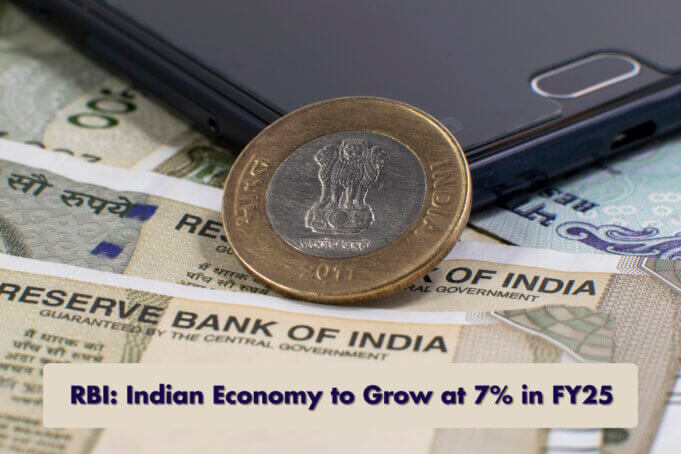Indian economy to grow at 7% in FY2025, the Reserve Bank of India (RBI) said in its annual report released on 30 May 2024.
In 2023, the global economy demonstrated resilience despite restrictive monetary policies, geopolitical tensions, and geo-economics fragmentation. Global GDP grew by 3.2%, slightly down from 3.5% in the previous year, driven by strong performance in the US and major emerging markets and developing economies (EMDEs). Global inflation eased to 6.8% from 8.7% in 2022, aided by monetary tightening and restored supply chains. However, pandemic-induced fiscal loosening increased global public debt amidst slow growth and high interest rates.
Global merchandise trade volume contracted by 1.2% in 2023, following a 3.0% expansion in 2022, due to rising trade restrictions and a shift in demand from goods to services. Financial markets experienced volatility as market participants reacted to changing perceptions of monetary policy. Sovereign bond yields rose in the year’s first half but showed significant fluctuations in the second half. The US dollar remained strong, putting pressure on emerging market economies (EMEs) currencies.
Despite global uncertainties, the Indian economy remained resilient in 2023-24, with real GDP growth improving to 7.6% from 7.0% in 2022-23, supported by strong fixed investment. The manufacturing sector benefited from lower input prices, while services maintained momentum, offsetting a slowdown in agriculture. Headline inflation moderated within the tolerance band due to anti-inflationary policies, supply management measures, and corrections in global commodity prices. Core inflation fell below 4% from December 2023.
India’s economic resilience persisted despite subdued external demand, geopolitical tensions, and volatile global financial markets. Real GDP growth was sustained above 7% for the third consecutive year, driven by robust fixed investment from government capital expenditure. Economic activity on the supply side was boosted by manufacturing profitability and sustained services activity, despite a slowdown in agriculture.
Private final consumption expenditure (PFCE), a key component of domestic demand, weakened in FY2024. Poor monsoon seasons affected kharif and rabi production, but two-wheeler sales indicated some recovery in rural demand in the second half of the fiscal year. Improved labour market conditions, higher disposable incomes, and double-digit growth in retail credit supported urban demand. Domestic air passenger traffic, railway passenger traffic, and vehicle sales showed strong growth. Both GST collections and e-way bill issuance expanded steadily. Government final consumption expenditure (GFCE) modestly expanded as the government pursued fiscal consolidation.
The gross domestic investment, measured by the gross capital formation (GCF) to GDP ratio, slightly decreased to 32.2% in FY2023 from 32.4% in the previous year. However, data for FY2024 suggests an uptick in investment, driven by government infrastructure projects and housing sector growth. The real gross fixed capital formation (GFCF) to GDP ratio increased to 34.1% from 33.3%. The construction sector showed robust growth, as indicated by increased steel consumption and cement production. Manufacturing sector capacity utilisation remained above average, reaching 74.7% in Q3/FY24.
Gross domestic savings as a percentage of gross national disposable income (GNDI) decreased to 29.7% in FY2023 from 30.8% due to a drop in household financial savings, which fell to 5.2% of GNDI from 7.2%. This decline was due to households drawing down excess savings accumulated during the pandemic. The saving-investment gap widened, driven by non-financial corporations, reflecting increased investment demand and a moderation in the saving rate.
Outlook for FY2025
Global Economy: The global economic outlook faces multiple challenges: persistent inflation, high public debt, financial stability risks from prolonged high interest rates, geopolitical tensions, geoeconomic fragmentation, and climate shocks. The global economy is projected to grow by 3.2% in both 2024 and 2025, with advanced economies growing by 1.7% and EMDEs by 4.2%.
Indian Economy: India’s economic outlook remains positive, supported by strong macroeconomic fundamentals, robust financial and corporate sectors, and a resilient external sector. Government investments in capital expenditure, coupled with consumer and business optimism, are expected to drive investment and consumption demand. Favourable agricultural prospects due to the ebbing El Nino and expected above-normal monsoon, along with government initiatives in food security and sustainable agriculture, will support rural activity.
The construction sector is likely to maintain its momentum, supported by demand in residential and non-residential real estate. Emerging sectors like renewable energy and semiconductors are expected to grow rapidly, aided by recent government initiatives. These factors are anticipated to create employment opportunities, improve labour incomes, and strengthen domestic demand. Real GDP growth for FY2025 is projected at 7.0%, with risks evenly balanced.
Source: RBI: Annual Report 2023-24











